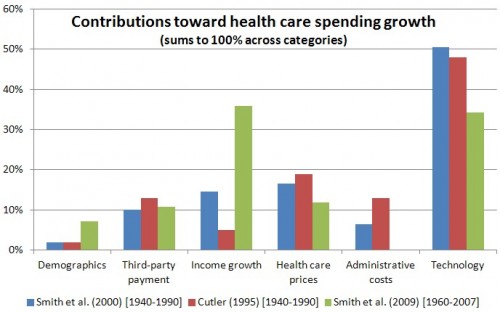I said I’d post this next week. I lied. Sorry. Here it is.
Two excellent sources on this question are the 2008 CBO report* and the 2009 paper by Smith, Newhouse, and Freeland. I made the following chart from the information in each, averaging the ranges of estimates they report.
Comments:
- None of the studies attribute any spending growth to increases in defensive medicine or supplier induced demand.
- Smith et al. (2009) doesn’t attribute any spending growth to changes in administrative costs.
- Smith et al. (2009) covers a time range about 20 years later than the other two studies.
- In all studies, technology is a large factor; only in Smith et al. (2009) does income growth dominate it. Does this reflect a shift over time in relative importance of causal factors or just differences in methodology?
- Income and technology interact. As wealth grows, so does the ability to afford more rapid technological change. Health care is now a large enough sector that its growth substantially helps fuel that of the wider economy.
- Health care spending can be decomposed into prices and quantities. Both play a role in encouraging or discouraging technology. All other things being equal, being able to charge (or be reimbursed) a high (or growing) price would encourage technology. Volume plays a role if there are economies of scale.
*Smith et al. (2000) and Cutler (1995) are cited in the CBO report. Follow the link for the full references.


